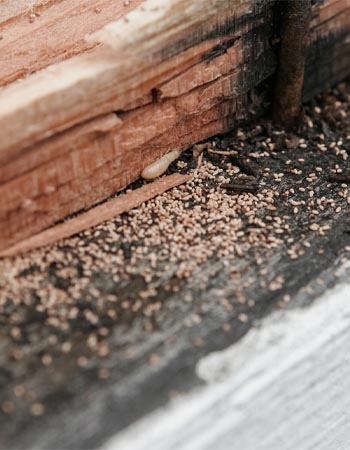We may earn revenue from the products available on this page and participate in affiliate programs. Learn More ›
Q: I’m concerned my house has termites. How can I tell if what I found are termite droppings? Is it possible there are old termite droppings but no termites?
A: Termite droppings signal an active nest of termites in the home. Termite droppings—also known as termite pellets, termite dust, termite poop, or termite frass—often look like piles of sawdust or pepper. Termite droppings can vary by the species of termite that left it. However, termites generally resemble tiny, wood-colored ovals (ranging in hue from black to light brown) and usually don’t exceed a length of 0.04 inches. Unfortunately, termite droppings won’t wear with time, which makes it hard to tell how long a dropping heap has been present. For homeowners concerned about termites in their house, this handy guide offers information about termites, their droppings, and what to do about them.
Termite droppings, or frass, will be located near a termite nest.

Termites—specifically drywood termites—prefer their living spaces free of droppings, so they create “kick-out” holes in wood to get rid of their frass. The kick-out holes are small and never used as an entrance. If a homeowner finds a kick-out hole with termite droppings but no termites, that does not mean the infestation is gone. The opposite is often true: The termites have most likely moved onto another part of the house, wall, or room for more food.
Termites’ droppings will be located near a termite nest for both drywood and subterranean termite infestations. However, homeowners will struggle to find subterranean termite droppings compared to drywood termite frass, as subterranean termites use their droppings to create mud tunnels rather than a frass pile.
Drywood termite droppings are small and oval-shaped, with six concave sides.
Drywood termites live in wood and almost never leave once they’ve found a home. Once the termite chooses its space, it seals the entrance and begins burrowing. Therefore, homeowners may have difficulty finding signs of an infestation outside of drywood termites’ droppings and kick-out holes.
Drywood termite droppings are oval-shape and look like grains of sand, ground pepper, or sawdust. Drywood termite frass color will change based on the type of wood the termite eats. Homeowners should expect the dry frass to be as small as a millimeter, with six concave sides.
Common places to look for a drywood termite infestation or drywood termite kick-out holes include:
- Wooden porches.
- In between wooden floorboards.
- Holes in the carpet (or under carpeting).
- Corners of walls.
- Attics and crawlspaces.
When investigating a potential termite dropping heap, homeowners may opt to use a magnifying glass to clearly see what characteristics the termite pellets have.

Termite frass looks similar to piles of sawdust, which are another sign of termite infestation.
As mentioned above, drywood termites use kick-out holes keep their frass out of their living space. Dampwood termites, which behave similar to drywood termites, will use their pellets to seal the galleries of wood they eat through. Finding damaged wood and nearby piles of termite frass remains the best indication of a termite infestation. Signs of termite infestation include piles of sawdust, damaged wood, and swarms of winged termites.
Homeowners should also consider odd insect behavior and patterns as a sign of termite infestation. Though they may get confused for winged ants, winged termites are a precursor to the start of a new termite colony. “Swarmers” also may indicate the presence of an existing colony, as those winged termites have left their original community to start a new one.
Subterranean termites typically don’t leave visible droppings.
Subterranean termites do as their name suggests—burrow underground and later infest a home. Between drywood and subterranean termites, the latter has the potential to do more damage.
Because subterranean termites don’t leave visible droppings, homeowners should know what to look for if they’re worried about termites. Three signs of a subterranean termite infestation include:
- Swarms of winged termites.
- Piles of discarded termite wings.
- Damaged wood.
If subterranean termites don’t leave visible droppings, what do their pellets look like? Unlike drywood termites, subterranean termite frass is wet—a mixture of saliva, dirt, and debris—and used to form mud tunnels. These mud tunnels become a transportation avenue for the termite colony to wreak havoc on foundations, walls, and more. Subterranean termites prefer warm, wet climates and may congregate in empty spaces, around leaking pipes, and other usually-inaccessible ways into a home.

Contact a pest control professional at the first sign of termites, like termite droppings.
Wondering what to do about termite droppings? A homeowner’s first action should be to contact a pest control company. Because many homeowner insurance policies don’t cover termite damage, it’s all the more important to address the problem as soon as it’s noticed.
Pest control companies will start by inspecting a home or property to analyze the extent of damage and identify the species of termite. Then, they’ll likely create a custom plan for treatment that may include liquid, foam, or bait and monitoring solutions. Some pest control companies use chemical solutions, fumigation, or tenting and heat.
Termite inspections can cost between $50 to $300 dollars depending on the situation, where a homeowner lives, and available pest control specialists. New home buyers should consider getting a termite inspection before moving in to ensure the foundation and walls of their new home are solid.
The cost of termite treatment varies widely based on custom plans and pest control providers. Other cost considerations with treatments include structural damage to be repaired and potential re-infestations.


